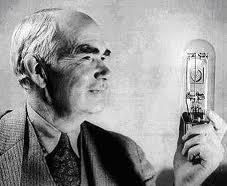-
(b.) -1873 August 26(d.)1961 June 30
Bio/Description
De Forest had an interest in wireless telegraphy and he invented the Audion in 1906. He then developed an improved wireless telegraph receiver. At that time, he was a member of the faculty at the Armour Institute of Technology, now part of the Illinois Institute of Technology.
In January 1906, De Forest filed a patent for diode vacuum tube detector, a two-electrode device for detecting electromagnetic waves, a variant of the Fleming valve invented two years earlier. One year later, De Forest filed a patent for a three-electrode device that was a much more sensitive detector of electromagetic waves. It was granted US Patent 879,532 in February 1908. The device was also called the De Forest valve, and since 1919 has been known as the triode. De Forest's innovation was the insertion of a third electrode, the grid, between the cathode (filament) and the anode (plate) of the previously invented diode. The resulting triode or three-electrode vacuum tube could be used as an amplifier of electrical signals, notably for radio reception. The Audion was the fastest electronic switching element of the time, and was later used in early digital electronics (such as computers). The triode was vital in the development of transcontinental telephone communications, radio, and radar after Nikola Tesla's and Guglielmo Marconi's progress in radio in the 1890s, until the 1948 invention of the transistor.
-
Date of Birth:
1873 August 26 -
Date of Death:
1961 June 30 -
Gender:
Male -
Noted For:
Inventor of the audion triode, audio and radio pioneer -
Category of Achievement:
-
More Info:


